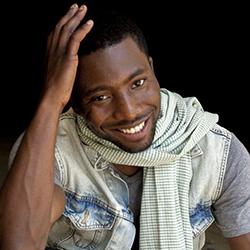Samad Raheem Guerra
Day Two: June 8, 2021
Samad Raheem Guerra's performance is a homage to his birth mother, Evette Raheem, whom he spent the greater half of his adult life trying to find. Although Samad does not recall the sound of her voice, the warmth of her skin, or the kindness of her heart, he knows that she loved him deeply.
Reflection Questions
Samad's piece reminds us that we can always communicate with our beloveds in the ancestral realm. What are some ways you and your ancestors communicate with each other? We invite you to dedicate some time today to meditate, write a letter, cook a meal, and engage in some creative practice to connect to one of your divine ancestors.
Artist Q&A
How do you embody liberation in your practice and creative works?
I’ve found liberation through the physical act of releasing and letting go of tension in my body. As a dancer, one of my goals is to experience freedom through movement. And this freedom is always achieved by letting go and allowing myself to enter a trance-like state. However, not all of my creative work is dance-based. Writing has also been a medium through which I’ve found liberation. The poem that I wrote helped me arrive at a place of love and forgiveness toward my birth mother who didn’t have the capacity to raise me after birth. In my opinion, liberation is also tied to love and forgiveness.
What organizers, activists and/r change-makers currently influence your work? What books/texts inform your work?
I’m very influenced by Marc Bamuthi Joseph, Marjani Forté-Saunders, Dana E. Fitchett, Favianna Rodriguez, Soul Nubian, d. Sabela grimes, and the work of the Embodiment Project. They are mainly BIPOC change-makers, artist-activists, and storytellers who bring all sorts of mediums to stage, including text, movement, theater, sound, etc. Books like Pleasure Activism by adrienne marie wrown, Genesis (Memory of Fire Trilogy) by Eduardo Galeano, and Anger by Thich Nhat Hanh have all informed my creative work over the years.
How do you and your community honor and uplift the legacy of Juneteenth?
In the past, I’ve performed at Juneteenth celebrations, helped host panel discussions on the topic of liberation, and organized events at residential centers for transitional age youth. Regardless of what I do or where I go, I always surround myself by community. However, more recently, I’ve put aside time for reading Black radical nonfiction, ancestor work, and meditation. This in addition to spending time out in the community has helped me better understand the meaning of liberation.
Artist

Samad Raheem Guerra
Dance Artist, Choreographer and Writer
Samad Raheem Guerra is a director, multidisciplinary performing artist and arts educator based in the San Francisco Bay Area. He received his BA in World Arts and Cultures/Dance from UCLA in 2014. Since graduating, he has worked as a teaching artist, program coordinator at a youth homeless shelter and toured internationally with CONTRA-TIEMPO. He has also performed at the Hollywood Bowl and Ford Amphitheater with Viver Brasil and Sergio Mendes, and co-produced his own work at the LACMA, Main Museum in downtown Los Angeles, Hamburger Bahnhof and daadgalerie in Berlin, Germany.
Currently, Guerra directs the World Dance program at S.O.T.A, an audition-based performing arts high school in San Francisco. When Guerra is not teaching or working on art projects, he enjoys spending time in the wilderness. A big part of his healing practice also includes the ancient practice of sweating, which involves prayer and meditation. It has helped him stay grounded and connect to his higher purpose in life. He is grateful to the community of Navajo elders and teachers who introduced him to the practice and continue to be a source of inspiration in his life. Aho Mitákuye Oyás’iŋ (To All My Relations)